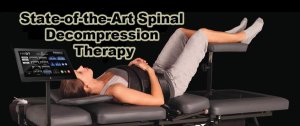 Spinal disc herniations are a common cause of back pain, discomfort, and limited mobility. These conditions occur when the soft, gel-like center of a spinal disc pushes through a tear in its outer layer, potentially compressing nearby nerves. This can lead to symptoms such as sharp pain, tingling, numbness, or weakness in the arms or legs. While various treatment options exist, spinal decompression therapy has emerged as a non-invasive and effective solution for relieving the pain and symptoms associated with disc herniations.
Spinal disc herniations are a common cause of back pain, discomfort, and limited mobility. These conditions occur when the soft, gel-like center of a spinal disc pushes through a tear in its outer layer, potentially compressing nearby nerves. This can lead to symptoms such as sharp pain, tingling, numbness, or weakness in the arms or legs. While various treatment options exist, spinal decompression therapy has emerged as a non-invasive and effective solution for relieving the pain and symptoms associated with disc herniations.
Understanding Spinal Decompression Therapy
Spinal decompression therapy is a non-surgical procedure designed to relieve pressure on the spinal discs and nerves. It involves the use of a specialized motorized table that gently stretches the spine, creating negative pressure within the discs. This process helps to:
Relieve Pressure: By decompressing the spine, the therapy reduces the stress on herniated or bulging discs, allowing them to retract.
Promote Healing: The negative pressure enhances nutrient and oxygen flow to the affected area, supporting the natural healing process.
Alleviate Nerve Compression: By reducing disc herniation, spinal decompression can relieve pressure on nearby nerves, alleviating pain and improving mobility.
Benefits of Spinal Decompression Therapy for Herniated Discs
1. Non-Invasive Relief
Unlike surgical interventions, spinal decompression therapy doesn’t involve incisions or lengthy recovery times. Patients can often resume their daily activities shortly after treatment sessions.
2. Improved Mobility
By reducing disc bulging and nerve compression, spinal decompression can help restore range of motion and improve overall mobility, allowing individuals to engage in physical activities without discomfort.
3. Long-Term Pain Management
Many patients experience lasting relief after completing a course of spinal decompression therapy. Combined with proper posture, exercise, and ergonomic habits, this treatment can significantly improve quality of life.
What to Expect During a Session
During spinal decompression therapy, the patient lies comfortably on a motorized table. A harness is placed around the pelvis and torso to secure the individual. The table then applies gentle traction to the spine, alternating between phases of stretching and relaxation. Each session typically lasts 20 minutes, and a full treatment plan may require 15 to 30 sessions, depending on the severity of the condition.
Is Spinal Decompression Therapy Right for You?
Spinal decompression therapy is suitable for many individuals suffering from herniated discs, degenerative disc disease, sciatica, or other spine-related conditions. However, it’s important to consult with a healthcare provider to determine if this treatment is appropriate for your specific needs. Patients with severe osteoporosis, fractures, or certain spinal conditions may not be candidates for this therapy.
Conclusion
Spinal decompression therapy offers a safe, non-invasive, and effective solution for managing the symptoms of spinal disc herniations. By reducing pressure on the spine, promoting natural healing, and improving mobility, this treatment can help patients regain their quality of life without the need for surgery.
If you’re struggling with back pain caused by a herniated disc, contact us today to learn more about spinal decompression therapy and whether it could be the key to your recovery.
